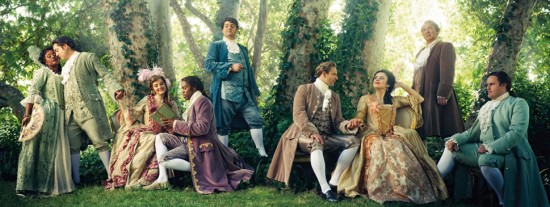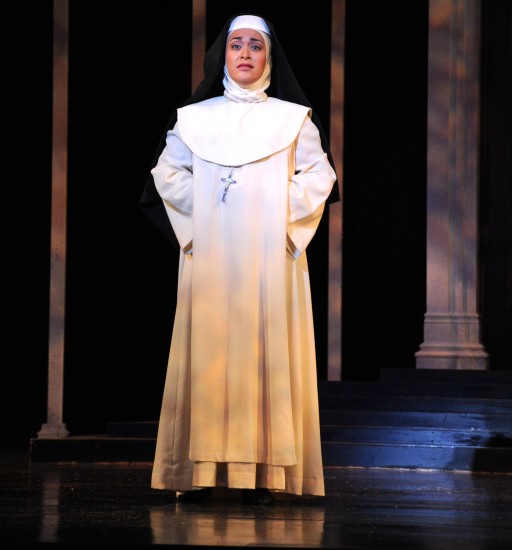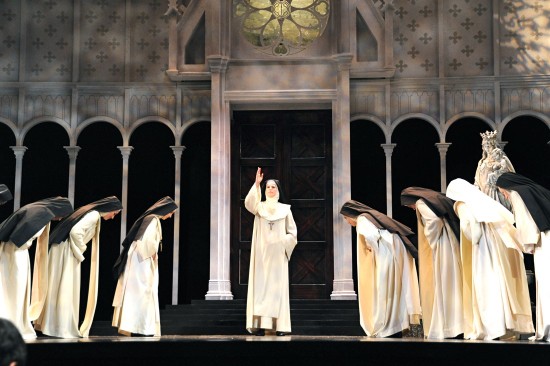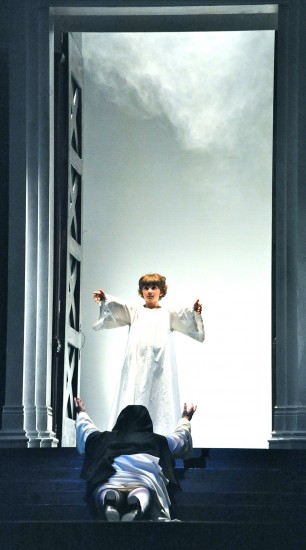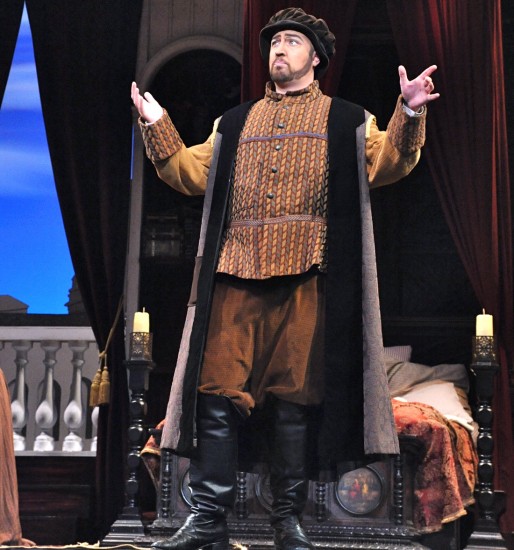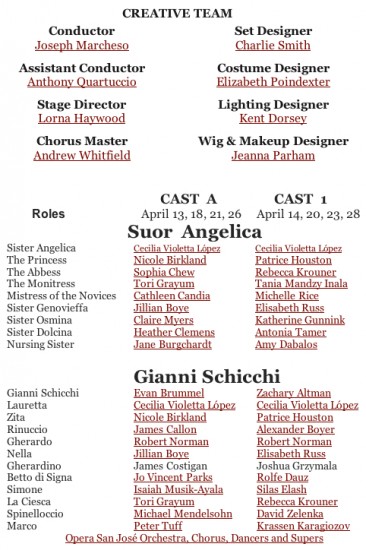There is so much to say about the wonderful production that I saw on Sunday, April 14, 2013, that I am going to do it in two reviews. Here is my review of Suor Angelica; the review of Gianni Schicchi will appear shortly. 
But before I begin, a few words from the¬†OSJ¬†web site¬†about¬†Opera¬†San Jos…:
The feature that makes Opera San Jos… unique in the United States is its¬†resident company of principal artists, formed in 1988, through which outstanding operatic artists in the first years of their careers are identified and awarded annual contracts to perform leading roles in mainstage productions and to participate in school and community-wide educational activities. These singers are groomed for international performing careers. Due to the resident nature of the company, modeled after the German regional opera company, these artists build substantial professional repertoire, are coached by resident and guest conductors and stage directors, and are prepared to meet the demands of a successful operatic career.
So that the maximum number of artists may receive this training, they are split into two balanced groups – Cast A and Cast 1 – and each cast sings 4 of the 8 performances of each opera. A serendipitous advantage of this scheme is that each cast automatically provides covers for the other. Thus when the Cast A soprano originally assigned the part of Angelica was unable to perform for this production,¬†Cecilia Violetta Lť≥pez¬†was available to sing the role with both casts. A slight downside from a reviewer’s viewpoint is that the picture I want at a certain point may only be available with the other cast. Thus there is sometimes a discrepancy between the artist’s name in the picture title and in the text.
On to the review. The overture to Suor Angelica starts serenely with a simple 8-bar tune based on the familiar quarter-hour chime of an old-fashioned clock. It is introduced on a set of chimes, the orchestra joins them bit by bit, then the curtain rises as an off-stage chorus of nuns adds a simple grace to the mix. All very calm and peaceful Рconvent life at its idealized best. A mild note of realism is introduced as a couple of nuns scurry across the stage and disappear into the chapel doorway at the rear.
I thought the stage was particularly impressive for its fuctional simplicity. The picture above shows only part of it, but it still gives you a good idea. The action all takes place int the courtyard in front of the chapel, so the back of the stage is the exterior of the chapel. We see the complete front including the peaked roof. The nuns at the (audience) right obscure a small fountain and pool and a bench at the base of the statue of Virgin and Child. Further to the left is another bench with a table, and a small herb garden. And that’s it. No irrelevant gimmicks to distract you from the intense human drama being played out here.
And drama it was. The nuns are allowed some free time, much of which they spend gossiping. Listening to their gossip, we learn the history of Sister Angelica (Cecilia Violetta Lť≥pez); seven years ago when she was an unmarried princess in the royal family, she gave birth to a child whose father was a commoner. The disgrace to the royal family was beyond atonement and could only be assuaged by their pretending it never happened. The baby boy was snatched from her immediately upon birth and Angelica was sent immediately to a convent to spend the rest of her life in repentance, never to be spoken of or communicated with again.
No sooner have we, the audience, become acquainted with Angelica’s history, than there is great excitement in the convent. A carriage bearing the Royal Seal is spotted driving up to the entrance. Angelica can scarcely contain herself – at last she will get news of her son! HAH! The Princess (Patrice Houston) sweeps onto the stage with all of the grace and subtlety (and a good start on the weight) of a German Panzer tank, nose in the air and vision pointedly directed anywhere but at Angelica. “Your little sister is getting married. You need to sign this paper relinquishing your dowry to her.” Words directed to empty space but obviously meant to be heard by Angelica. She immediately responds with joy and excitement, “My little sister. Grown up and getting married. Wonderful. Of course, I’ll sign. But first tell me of my son.”
(Silence. Nothing but silence.)
“Please tell me about my son, Princess. For seven years my only desire has been for news of that baby who was taken from me the instant he was born.” “Give up your desire. You are here to repent your sin, not to have desires.” “I have given the Virgin everything else I have; I cannot give up the love I bear my son. Give me news, Princess; give me news.
(Silence. Nothing but silence.)
Angelica snaps. Gone is the humble respect due to royalty. Gone is the quiet gentle demeanor of a nun. She turns on the Princess in fury: “You are inhuman. The Virgin is watching you. You will go to Hell. Tell me about my son!” The Princess moves ponderously to the right side of stage and addresses the Virgin’s statue: “Two years ago your son became ill. We did everything we could to save him. He died.”
Angelica screams “My son is dead” and falls to the floor, sobbing. Still sobbing she crawls to the desk, reaches for a pen, signs the paper, and collapses. The Princess sends her maid to pick up the paper, takes it from her, and exits without another word or backward glance. During all of her time on stage she never looked directly at Angelica. Nice gal, huh.
Meanwhile, Angelica slowly regains her composure. Suddenly her face brightens. Yes, her son is dead. But that means, “You are now an angel in Heaven. You are looking at me now so I can tell you how much I love you. How much I look forward to joining you in Heaven. How long must I wait before I join you? Can I join you now? Please send me a sign.”
Apparently she believes she has received a “go ahead” sign. She rapidly uses her knowledge of herbs to brew a poison, which she drinks. All with beatific smile on her face.
Suddenly her face changes to horror as she realizes that she has committed the most deadly of all mortal sins – Suicide. She will not join her son in Heaven. She is bound for Hell. As the poison quickly takes effect she prays desperately to the Virgin. “Forgive me, please, oh please forgive me. Everything I did I did for love. Only for love.” As she falls lifeless at the foot of the statue the music changes from somber to sonorous with brighter tones and rising pitch – the music of redemption. The light grows brighter and brighter. The chapel door bursts open, but we don’t see the chapel interior, we see a streaming bright light with a young boy walking towards us – Angelica’s son, come to bring his mother back to heaven with him. Curtain, thunderous applause, curtain calls with the audience rising as one when¬†Cecilia Violetta Lť≥pez took her bow.
Twenty-minute intermission to come down from that peak emotion and get ready to laugh with Gianni Schicchi. I’ll tell you about that in Part II. Meanwhile, go to the¬†Opera San Jos… website¬†and order your tickets for one of the remaining performances, as shown in the Cast table below.
This review by Philip G Hodge appeared in sanfranciscosplash.com on April 16, 2013.

